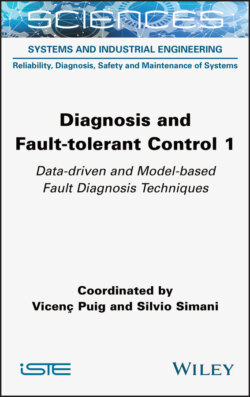Diagnosis and Fault-tolerant Control 1

Реклама. ООО «ЛитРес», ИНН: 7719571260.
Оглавление
Группа авторов. Diagnosis and Fault-tolerant Control 1
Table of Contents
List of Illustrations
List of Tables
Guide
Pages
Diagnosis and Fault-tolerant Control 1. Data-driven and Model-based Fault Diagnosis Techniques
Introduction
I.1. Introduction
I.2. Nomenclature
I.3. Fault diagnosis methods based on analytical redundancy
I.4. Model-based fault diagnosis
I.5. Model uncertainty and fault detection
I.6. Robust fault diagnosis
I.7. Data–driven approaches to robust FDI
I.8. Data-driven methods for fault diagnosis
I.9. FDI application report
I.10. From FDI to FTC
I.11. Structure of the book
I.12. Summary
I.13. References
1. Mathematical Modeling and Fault Description
1.1. Introduction
1.2. Model-based FDI Techniques
1.3. Modeling of faulty systems
1.3.1. Fault modeling and description
1.3.2. Mathematical description
1.4. Residual generation
1.5. Residual generation techniques
1.5.1. Residual generation via parameter estimation
1.5.1.1. Equation error methods
1.5.1.2. Output error methods
1.5.2. Observer-based approaches
1.5.3. Fault detection via parity equations
1.6. Change detection and symptom evaluation
1.7. Residual generation robustness problem
1.7.1. FDI H∞approach
1.7.2. Active and passive disturbance de-coupling
1.8. Fault diagnosis technique integration
1.8.1. Fuzzy logic for residual generation
1.8.2. Neural networks for fault diagnosis
1.8.3. Neuro-fuzzy approaches to FDI
1.8.4. Fault detectability and isolability
1.8.5. NF model structure identification
1.8.6. NF residual generation for FDI
1.9. Conclusion
1.10. References
2. Structural Analysis
2.1. Introduction
2.2. Background
2.2.1. Structural models
2.2.2. Dulmage–Mendelsohn decomposition and matchings
2.2.3. Dulmage–Mendelsohn decomposition and simulation
2.3. Fault isolability analysis
2.3.1. Fault detectability analysis
2.3.2. Fault isolability analysis
2.3.3. Canonical isolability decomposition of the overdetermined part
2.4. Testable submodels
2.4.1. Basic definitions
2.4.2. MSO algorithm
2.4.3. Residual generation based on matching
2.5. Sensor placement
2.5.1. The basic sensor placement problem
2.5.2. A structural approach
2.5.2.1. Sensor placement for detectability
2.5.2.2. Sensor placement for isolability of detectable faults
2.5.2.3. Sensor placement for both detectability and isolability
2.6. Summary and discussion
2.7. References
3. Set-based Fault Detection and Isolation
3.1. Introduction
3.2. Notations, definitions and properties
3.3. Problem statement. 3.3.1. Uncertain discrete-time linear systems
3.3.2. Set-based methods
Algorithm 3.1. Set-membership state estimator
Algorithm 3.2. Set-based observer
3.3.3. FDI problem statement
3.4. Proposed techniques
3.4.1. Set-membership approach
3.4.2. Zonotopic observer
3.4.3. Relationship between set-based methods
3.5. Design methods
3.5.1. Robustness conditions
3.5.2. Fault sensitivity condition
3.6. Fault detection and isolation procedures
3.6.1. Fault detection. 3.6.1.1. Set-membership estimation
Algorithm 3.3. Fault detection using set-membership state estimator
3.6.1.2. Zonotopic observer
Algorithm 3.4. Fault detection using interval observers
3.6.2. Fault isolation
3.7. Application example: quadruple-tank system
3.7.1. Results with robustness condition
3.7.2. Results with robustness and fault sensitivity conditions
3.8. Conclusion
3.9. References
4. Diagnosis of Stochastic Systems
4.1. Introduction
4.2. Stochastic diagnosis task. 4.2.1. Notation
4.2.2. Problem formulation
4.2.3. Representing uncertainty
4.3. Inference methods for diagnosis task
4.3.1. Difference with other tasks
4.4. Model-based approach
4.4.1. Traditional FDD methods. 4.4.1.1. Overview of FDD methods
4.4.1.2. Examples of FDD methods
4.4.2. Bayesian inversion/filtering
4.4.2.1. Inference methods
4.5. Data-driven approaches
4.5.1. ML methods
4.5.2. Statistical methods
4.6. Hybrid approaches: surrogate methods
4.6.1. Fitting surrogate models via sampling
4.6.1.1. Fitting surrogate models with data
4.7. Comparative analysis of approaches
4.8. Summary and conclusions
4.9. References
5. Data-Driven Methods for Fault Diagnosis
5.1. Introduction
5.2. Models for linear system fault diagnosis
5.3. Parameter estimation methods for fault diagnosis
5.3.1. Data–driven method in ideal conditions
5.3.2. Data-driven methods in real scenarios
5.3.3. Algebraic Frisch scheme
5.3.4. Dynamic Frisch scheme
5.3.5. MIMO case Frisch scheme
5.4. Nonlinear dynamic system identification
5.4.1. Piecewise affine model
5.4.2. Hybrid model structure
5.4.3. Nonlinear system approximation
5.4.4. Model continuity and domain partitioning
5.4.5. Local affine model estimation
5.4.6. Multiple-model estimation
5.5. Fuzzy data-driven approach to fault diagnosis
5.5.1. Fuzzy model identification
5.5.2. Takagi–Sugeno prototypes
5.5.3. Data-driven Fuzzy modeling
5.5.4. Clustering methods
5.5.5. Fuzzy c-means clustering algorithms
5.5.6. Gustafson–Kessel clustering algorithm
5.5.7. Optimal number of clusters
5.6. Fuzzy model identification
5.6.1. Nonlinear model identification
5.6.2. Product space clustering identification
5.6.3. Fuzzy clustering model identification
5.6.4. Antecedent membership function estimation
5.6.5. Estimating consequent parameters
5.7. Conclusion
5.8. References
6. The Artificial Intelligence Approach to Model-based Diagnosis
6.1. Introduction
6.2. Case studies
6.3. Knowledge-based diagnosis systems
6.3.1. Diagnosis task and system model
6.3.1.1. Clancey “heuristic classification”
6.3.2. Diagnosis of physical devices
6.3.3. Limits of KBS for diagnosis of physical devices
6.4. Model-based diagnosis
6.4.1. Formalization of consistency-based diagnosis and its first implementation, GDE. 6.4.1.1. The theoretical framework
6.4.1.2. The computational framework: GDE
6.4.1.3. Computational alternatives to GDE
6.5. CBD for dynamic systems
6.5.1. Different approaches for CBD of dynamic systems
6.5.2. PCs for the three-tank system case study
6.6. Conclusion
6.7. References
List of Authors
Index. A, B
C, D
E, F
G, H
M
N, O, P
R
S
T, U
Summary of Volume 2
WILEY END USER LICENSE AGREEMENT
Отрывок из книги
Systems and Industrial Engineering, Field Director – Jean-Paul Bourrières
.....
On the other hand, the analytical models that the nonlinear observer approaches are based on are not easy to obtain in practice. Sometimes, it is impossible to model the system using an explicit mathematical model. To overcome this problem, it is desirable to find a universal approximate model that can be used to represent the real system with an arbitrary degree of accuracy. Different approaches were proposed and they are currently under investigation: neural networks, fuzzy models and hybrid models.
As shown in Simani et al. (2003) and Simani and Farsoni (2018), fuzzy systems and neural networks are a powerful tool for handling nonlinear problems. One of the most important advantages of neural networks is their ability to implement nonlinear transformations for functional approximation problems. Therefore, neural networks can be used in a number of ways to tackle fault diagnosis problems for nonlinear dynamic systems. In existing publications, they were mainly exploited as fault classifier with steady-state processes, whereas neural networks have been used as residual generators and for modeling nonlinear dynamic systems for FDI purposes (Chen and Patton 1999).
.....